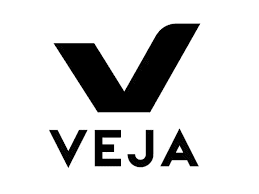10 Most Sustainable Leather Clothing Brands: The Conscious Consumer’s Guide
Affiliate Disclosure
Hey fellow impactful ninja ?
You may have noticed that Impactful Ninja is all about providing helpful information to make a positive impact on the world and society. And that we love to link back to where we found all the information for each of our posts.
Most of these links are informational-based for you to check out their primary sources with one click.
But some of these links are so-called "affiliate links" to products that we recommend.
Why do we add these product links?
First and foremost, because we believe that they add value to you. For example, when we wrote a post about the environmental impact of long showers, we came across an EPA recommendation to use WaterSense showerheads. So we linked to where you can find them. Or, for many of our posts, we also link to our favorite books on that topic so that you can get a much more holistic overview than one single blog post could provide.
And when there is an affiliate program for these products, we sign up for it. For example, as Amazon Associates, we earn from qualifying purchases.
What do these affiliate links mean for you?
First, and most importantly, we still only recommend products that we believe add value for you.
When you buy something through one of our affiliate links, we may earn a small commission - but at no additional costs to you.
And when you buy something through a link that is not an affiliate link, we won’t receive any commission but we’ll still be happy to have helped you.
What do these affiliate links mean for us?
When we find products that we believe add value to you and the seller has an affiliate program, we sign up for it.
When you buy something through one of our affiliate links, we may earn a small commission (at no extra costs to you).
And at this point in time, all money is reinvested in sharing the most helpful content with you. This includes all operating costs for running this site and the content creation itself.
What does this mean for me personally?
You may have noticed by the way Impactful Ninja is operated that money is not the driving factor behind it. It is a passion project of mine and I love to share helpful information with you to make a positive impact on the world and society. However, it's a project in that I invest a lot of time and also quite some money.
Eventually, my dream is to one day turn this passion project into my full-time job and provide even more helpful information. But that's still a long time to go.
Stay impactful,
Amid growing concerns about the textile industry’s environmental impact and cruelty toward animals, clothing brands are moving away from animal-derived leather, a material with a long history and a troublesome modern-day reality. However, leather has superior strength needed in certain clothing items and is hard to find in alternative fabrics. So, we had to ask: Which are the most sustainable leather clothing brands?
The most sustainable leather clothing brands are HYER GOODS, BEEN London, and Better World Fashion, which utilize waste to make their products and strive for circularity in the life-cycle of their items. In addition, Baukjen and Reformation lower carbon footprints and adhere to ethical practices.
Whether you are searching for a jacket, a pair of sneakers, or an everyday bag to add to your wardrobe without negatively impacting the soil, the water, the animals, and other people, there is a brand for you. So, let’s keep reading to learn more about the most sustainable leather clothing brands and how they ensure sustainable, ethical practices.
Here’s How Sustainable Leather Fabrics Generally Are
Leather fabrics are made with animal skins, traditionally sourced as byproduct waste after animal slaughtering for food. Today’s leather production often involves toxic chemicals, which pose health risks to workers and contaminate the environment, affecting the sustainability of the materials. There are also ethical concerns about animal farming, which provides meat for the food industry and skins for the leather industry.
“Sustainable: The ability to be maintained at a certain rate or level | Avoidance of the depletion of natural resources in order to maintain an ecological balance”
Oxford Dictionary
To understand the sustainability of leather, we’ve assessed the life-cycle and each stage’s sustainability. This life-cycle assessment (LCA) is a method to evaluate the environmental impacts of products and materials. Here’s the quick summary of our LCA of leather!
What makes sustainable leather: Upcycled leather is considered the most sustainable leather variety because recirculating leather waste like deadstock, surplus, or leftovers to make leather products reduces pressure on land, water, and other resources needed for rearing more animals.
Additionally: Sourcing animal skins as a byproduct of sustainable meat farms and tanning the skin with vegetable extracts lower the adverse impacts of this material, making it more sustainable.
Here’s How We Selected the Most Sustainable Wool Clothing Brands
The brands on this list were chosen based on their commitment and actions to promote sustainable practices while reducing the environmental impacts of the textile industry.
They are transparent about their materials, processes, and workforce management within their supply chain.
Some brands focus their efforts on reducing waste and optimizing natural resources while others strive to reduce the carbon footprint of their clothes.
All of these brands share the commitment to reshape the textile industry toward a more sustainable and Earth-friendly sector.
These Are the 10 Most Sustainable Wool Clothing Brands
Most Sustainable Wool Clothing Brands
Overall, these leather clothing brands are sustainable. Yet, they take various approaches to reduce environmental impacts and uphold ethical standards. Let’s dive into each brand and find out more.
HYER GOODS: Clothes and Accessories Made With Deadstock
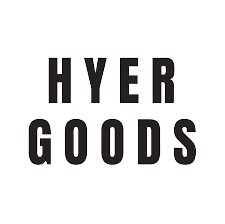
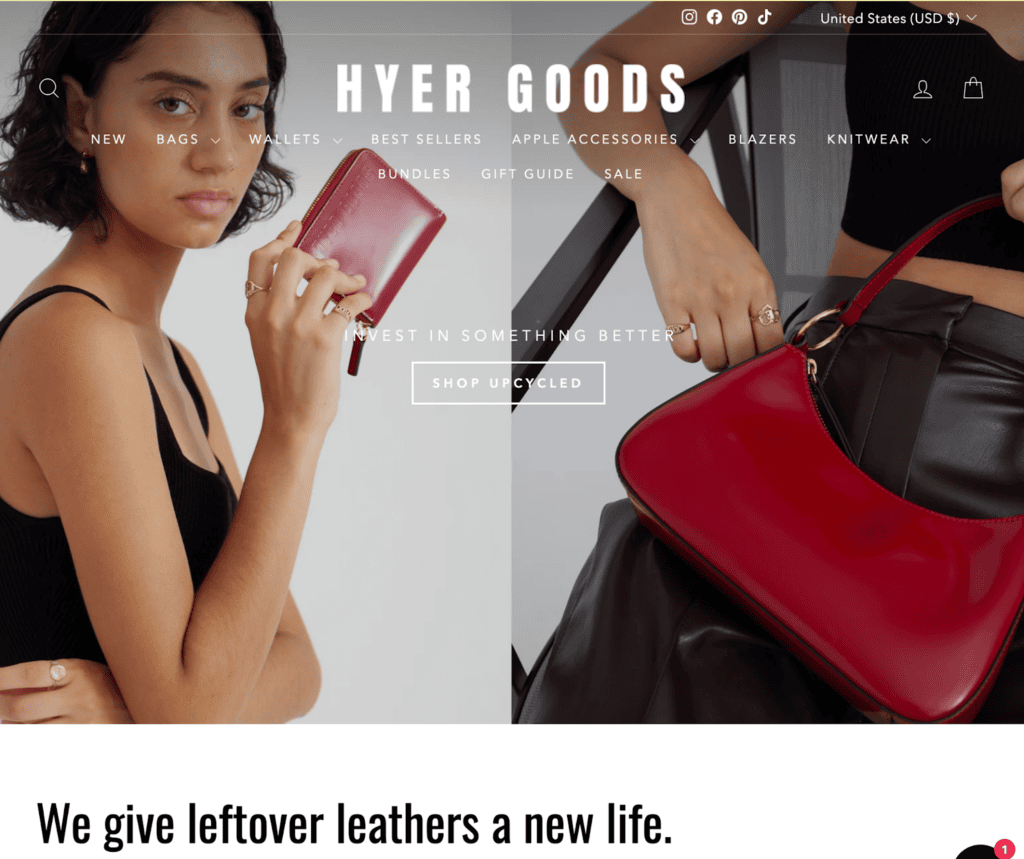
“By upcycling “trash” we eliminate the massive energy footprint needed to cultivate land, livestock, crops and fertilizers, while simultaneously reducing the amount of waste being sent to landfill. ”
HYER GOODS
🌎
How do they ensure their sustainability?
HYER GOODS ensures their sustainability by rescuing yarns and fabrics abandoned by the fashion industry and turning them into beautiful bags, clothing items, and accessories.
- For example, their Luxe Mini Bucket Bag is cut from leather leftovers. Their entire collection of bags, wallets, jackets, and beanies are also crafted from deadstock, surplus, and leftovers, including luxury leftover leather, deadstock leather, locally sourced abandoned wool yarns, and deadstock canvas.
- Regarding their leather materials, HYER GOODS prioritizes using animal skins that are vegetable-tanned and made in Italy, utilizing some of the world’s best leather production methods. Also, all of the ready-made leather leftovers they source are tested for chrome, ensuring the leather is safe to wear. Beyond reducing carbon emissions through diverting textile waste from landfills, HYER GOODS offsets 100% of their carbon emissions from shipping.
- Lastly, they partner with EcoCart to support Global Sustainable Infrastructure Projects, investing in multiple sustainable infrastructure carbon offset projects, like wind and solar farms, biogas, and hydropower.
🌐
How do they ensure their ethics?
HYER GOODS traces most of their supply chain and audits their final stage of production.
🤝
Are they part of any giving-back programs?
HYER GOODS has pledged to donate 1% of net sales on their site to support organizations that foster the physical and mental well-being of people in need. Some of the previous recipients of their donations are the Malala Fund, WHO, No Kid Hungry, and The Okra Project.
🛍️
What is their product range?
- Best for: menswear, womenswear
- Product range: bags, wallets, blazers, beanies, scarves
- Price range: $$$
- Size range: XS–L
BEEN London: Timeless Accessories From Recycled Leather Offcuts and Plastic Bottles
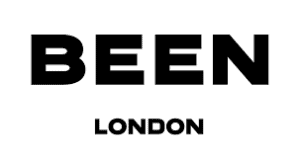

“We make versatile, timeless accessories from discarded materials that would otherwise go to landfill. In doing so, we are shifting the narrative around waste, showing what is possible with new innovations, and doing our part to protect nature.”
BEEN London
🌎
How do they ensure their sustainability?
BEEN London’s sustainability efforts focus on circularity.
- They start with reverting waste away from landfills and into making clothing accessories. BEEN London also uses a high proportion of low-impact materials, including GRS-certified recycled materials from post-consumer plastic bottles, fishing nets, plant-derived waste, used textiles, and leather offcuts and trimmings. Specifically, they source recycled leather, recycled nylon, recycled polyester, recycled cotton, and recycled fell.
- Additionally, they have some bags made with vegan leather alternatives, including Piñatex and AppleSkinTM, made with agricultural and industry waste. Beyond sourcing, BEEN London also considers circularity in every decision. Specifically, they strive to limit the amount of waste they create through their design process, such as opting for making mostly rectangular bags with which they can achieve near zero offcuts. Any offcuts that are created in the production process are collected and recycled.
- Furthermore, they design durable, versatile, seasonless, timeless pieces that consumers will still want to wear year after year. BEEN London helps extend product lifespan by offering repairs and incentivizing end-of-life recirculating. The design of their bags also covers end-of-life recycling, meaning that they preempt the dismantling challenges by stitching the lining to bags and using water-soluble glues or leaving their bags unlined. When reuse and repair are no longer an option, customers can send their bags back to BEEN London, where they will be dismantled for material recycling.
- Lastly, BEEN London strives to reduce their climate impact by opting for sea freight and offering zero-emission London delivery.
🌐
How do they ensure their ethics?
BEEN London makes everything locally in East London to ensure the highest level of transparency. They also trace all of their supply chain and visit their suppliers regularly.
🤝
Are they part of any giving-back programs?
BEEN London gives back by planting trees in the Amazon Rainforests. They plant a tree for every leather item in the color Rainforest Green ordered and sold. The impact of their reforestation efforts is tracked via Forest of BEEN London on their partner platform, Tree-Nation. Additionally, BEEN London supports Smart Works, a charity that gives women the confidence they need to reach their full potential by incentivizing customers to bring or mail (pre-paid) their pre-loved bags from any brand for recirculating.
🛍️
What is their product range?
- Best for: womenswear
- Product range: backpacks, handbags, satchels, totes, wallets, purses
- Price range: $$$
- Size range: n/a
Better World Fashion: Circular Leather Clothes and Accessories
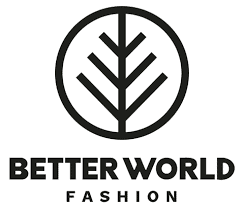

“We transform used leather, discarded plastic bottles and recycled wood and metal into new modern leather jackets, bags and other lifestyle products.”
Better World Fashion
🌎
How do they ensure their sustainability?
Better World Fashion ensures sustainability by using a high proportion of eco-friendly materials, including recycled fabrics from discarded leather, plastic bottles, and wood.
- For example, the leather used in their jackets is vintage leather, and the lining is recycled polyester, while zippers and buttons are made of re-melted metal.
- Additionally, every jacket comes with a lifetime buy-back guarantee, incentivizing customers to return their clothing items for recycling at any point with 50% off their next purchase in the same product category. Beyond recycling materials, Better World Fashion further reduces their climate impact by manufacturing locally.
- Lastly, Better World Fashion strives to avoid unnecessary waste by offering a rental subscription.
🌐
How do they ensure their ethics?
Better World Fashion ensures their ethics by choosing manufacturing partners whose values match theirs. They work with a family-owned company in Poland, which employs adults and provides good working conditions without exposure to toxic chemicals.
🤝
Are they part of any giving-back programs?
Better World Fashion is not known to be part of any giving-back programs.
🛍️
What is their product range?
- Best for: womenswear, menswear
- Product range: jackets, bags, accessories
- Price range: $$
- Size range: XS–3XL
Baukjen: Womenswear Designed for Circularity and Made Sustainably


“Our collections are designed for the modern woman struggling with a busy lifestyle. Effortless style is our design signature, premium quality is our standard so our clothes can be worn year after year.”
Baukjen
🌎
How do they ensure their sustainability?
Baukjen ensures sustainability by swapping planet-unfriendly materials for more responsible ones, cutting down environmental impacts throughout their supply chain, and moving toward a circular model.
- They lower their impact and contribute to a circular materials economy by increasing the proportion of recycled fibers (Ecotec recycled cotton, recycled sheep wool, recycled cashmere, Newlife recycled polyester, recycled down) and regenerative fibers. For example, in the second quarter of 2023, 98.6% of the materials used were from responsible sources with traceable origins, while 98.2% of the fibers used had a proven lower environmental impact.
- With high-impact textiles like leather, Baukjen reduces the adverse impacts by opting for exclusive by-products of food production and sourcing from tanneries that use vegetable extracts, such as tree bark and leaves, instead of nonrenewable metal salts.
- Further down the life-cycle in the manufacturing stage, they continue to lower the impacts by reducing water usage, using 100% renewable energy in offices and warehouses to decrease their carbon footprint, and minimizing manufacturing waste. For example, the water consumption and carbon emissions in the second quarter of 2023 were 47% and 31% lower than the same quarter in 2020, respectively.
- Baukjen is also a Zero Waste business, meaning that over 90% of their “waste” is neither landfilled nor incinerated. Once finished, their garments are shipped in 100% plastic-free, recyclable, and biodegradable packaging made from a recycled paper mix certified by FSC or PEFC.
- Lastly, Baukjen strives toward circularity through their re-commerce initiatives: Pre-Loved, Rental, and Care and Repair
🌐
How do they ensure their ethics?
Baukjen ensures their ethics by maintaining a high level of transparency regarding their factories and the impacts of their garments.
- They share the list of their factories, from Tier 1 to Tier 3 suppliers. Their Code of Conduct, signed by all direct suppliers (Tier 1) and some indirect suppliers (Tier 2), covers all of ILO’s Fundamental Freedoms principles.
- They also visit their factories regularly and enforce third-party audits.
- Additionally, they offer insights into the sustainable attributes of each item in their collection, such as the impact, the traceability, the carbon emission, and the nature of the fibers used.
🤝
Are they part of any giving-back programs?
Baukjen gives at least 10% of their annual profits to charities, including NHS Charities Together, GOSH, Oxfam, Strut Safe, World Land Trust, Prince’s Trust, and Birth Companions. Their team is offered two days per year to volunteer at charities of their choice. For three years running, they swapped deals for good deeds over the Black Friday Weekend, opting instead to donate profits or clothing over the four-day shopping bonanza to a range of deserving charities, such as the UK women’s charity Smart Works.
🛍️
What is their product range?
- Best for: womenswear
- Product range: shirts, blouses, sweatshirts, cardigans, dresses, tops, jackets, blazers, outerwear, T-shirts, vests, jeans, pants, skirts, knitwear, jumpsuits, joggers, pajamas, underwear, tights, maternity wear
- Price range: $$
- Size range: XS–XXL
Reformation: Pre-Loved Leather Clothes From Sustainable Brand

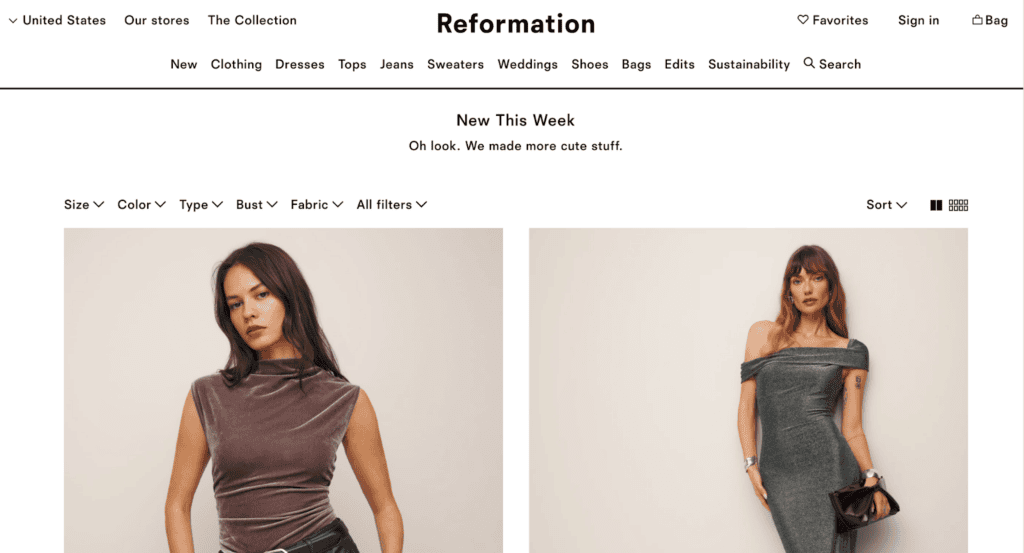
“We’re committed to pushing the industry forward and investing in future-focused solutions, which is why we’re a certified Climate Neutral company and will be Climate Positive by 2025.”
Reformation
🌎
How do they ensure their sustainability?
Reformation commits to better fabrics, aiming to trade all virgin materials for recycled, regenerative, or renewable ones by 2025.
- Their most preferred fabrics include recycled cotton, regenerative cotton, TENCEL™ Lyocell, TENCEL™ x REFIBRA™, and deadstock, accounting for 32% of all their clothes. They have committed to becoming circular by 2030 by designing out waste at every stage of production, turning any occurring production waste into new products, and using renewable and regenerative practices for necessary virgin materials.
- Furthermore, their RefRecycling incentive enables customers to sell their preloved Reformation clothes for store credits. Such items will be broken down into fibers and turned into new products.
- Reformation also connects their suppliers with environmental solutions such as renewable energy, water-saving technologies, energy reduction solutions, chemical input optimization, and wastewater management. In addition to that, they openly share the carbon and water footprint of each product they make, fostering transparency and accountability in the fashion industry.
🌐
How do they ensure their ethics?
Reformation is fully transparent about where their clothes are made and the practices in such factories.
- Their Supplier Code of Conduct is based on International Labor Organization (ILO) standards.
- Furthermore, their factory list shares many details about their factories, including whether a union and a collective bargaining agreement are present and the last audit. They have also aligned with the Transparency Pledge and are participating in the Open Supply Hub to expand on the details that are made public so they can be more accountable for the working conditions in their partner factories.
- On top of that, they give workers at their vendors a voice to bring up problems regarding their working conditions, level of happiness, working hours, and wages, and collaborate with vendors to ensure necessary improvements. Reformation is also a member of the Fair Labor Association, an initiative committed to promoting fair labor standards worldwide.
🤝
Are they part of any giving-back programs?
Reformation is not known to be part of any giving-back programs.
🛍️
What is their product range?
- Best for: womenswear
- Product range: dresses, tops, bodysuits, denim, cardigans, sweaters, wedding dresses, shoes
- Price range: $$$
- Size range: XS–XL
CARIUMA: Sneakers Designed for Style, Comfort, and Sustainability
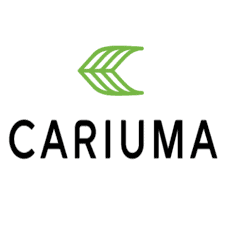

“We iterate a sneaker style for a year + before we bring it to production and we attempt to reduce the number of steps it takes to manufacture (which saves energy and time).”
CARIUMA
🌎
How do they ensure their sustainability?
CARIUMA prioritizes sustainability by increasing the natural content of their products.
- In particular, they prioritize materials that renew quickly, like bamboo and sugarcane, and plant-derived substances, such as cork and rubber, that can be harvested without cutting down trees. CARIUMA also sources lower-impact alternatives to conventional sneaker materials, for example, organic cotton instead of cotton, mamona oil instead of petroleum, recycled nylon instead of virgin nylon, and rPET (recycled PET—polyethylene terephthalate—plastic) instead of virgin plastics.
- The leather used in CARIUMA sneakers is sourced, tanned, and finished with low-waste methods, renewable and recycled inputs, and fewer chemicals. Their responsible practices involve recycled water, renewable energy, and a closed-loop tanning chemical system to protect the surrounding land and groundwater. CARIUMA exclusively sources leather as a byproduct of best-practice food industry cattle, which are steroid-free and grass-fed on naturally treeless plains indigenous to South America.
- Furthermore, they reduce their carbon footprint via a series of initiatives, including using solar energy, LED lighting, and a cooling tower in their warehouse, delivering sneakers in one recycled and recyclable paper box (which acts as both packaging and a shoe box), and opting for a carbon-neutral shipping option.
🌐
How do they ensure their ethics?
CARIUMA binds their suppliers to a Code of Conduct that covers all of the ILO’s Fundamental Principles and Rights at Work.
- They also trace most of their supply, specifically 100% of Tier 1 suppliers—the footwear manufacturer; 85% of Tier 2 suppliers involving raw material processors, mills, knitting, packaging, outsole factory, and components in general; and 59% of their Tier 3 suppliers who provide yarns, polymers, and chips.
- Additionally, their manufacturing partner is audited annually by WRAP. They also visit their suppliers routinely. Regarding the use of animal skins in their leather sneakers, CARIUMA has an Animal Welfare Policy, ensuring animal welfare standards and transparency in the leather supply chain.
- Lastly, their leather suppliers are certified and audited by the Leather Working Group (LWG).
🤝
Are they part of any giving-back programs?
Since June 2020, CARIUMA has committed to planting two trees for every pair of sneakers they sell. Their reforestation program started in Brazil, with over 2 million trees planted. They work closely with the local indigenous communities, following their guidance on how to tend to the land and best support regrowth and restoration, improve seed storage efficiency, and go about replanting methods that mitigate risk and preserve biodiversity.
🛍️
What is their product range?
- Best for: womenswear, menswear
- Product range: sneakers
- Price range: $$
- Size range: XS–XL
Nothing New: Sneakers of Luxury Quality Built With Sustainable Materials

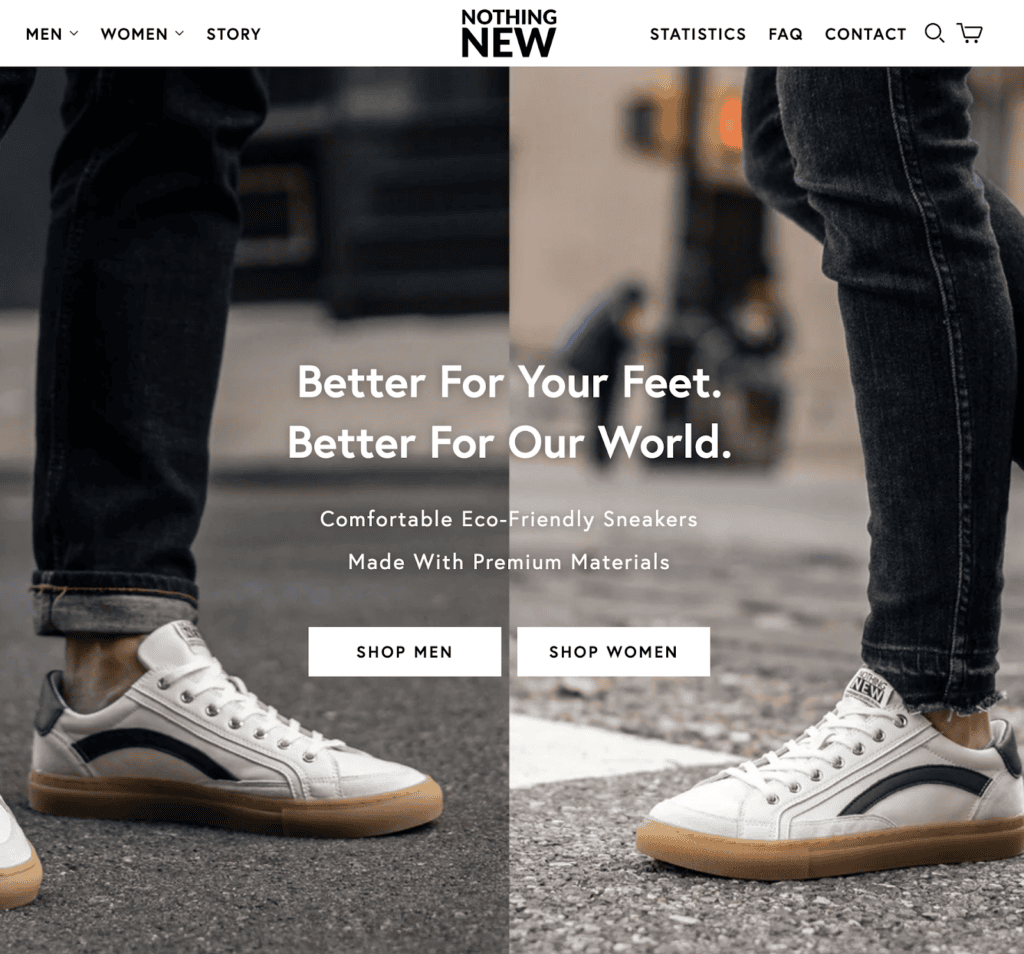
“By helping develop best-in-class sustainable products and investing in programs to minimize our environmental footprint, we hope to raise the bar for what customers expect from brands and contribute to the change we.”
Nothing New
🌎
How do they ensure their sustainability?
Nothing New ensures sustainability by lowering their carbon footprint.
- They achieve this firstly by prioritizing recycled materials to make their streetwear and packaging. Their Beyond CanvasTM is canvas material based entirely on post-consumer recycled plastic with Global Recycle Standard (GRS) certification, reverting on average 5.6 plastic water bottles away from landfills per pair of sneakers. Nothing New also rescues leather to make Beyond LeatherTM, another upper sneaker material certified by GRS. The suede leather used in some of their shoes is manufactured chrome-free by a tannery with a gold standard from the Leather Working Group. Further down the life-cycle in the manufacturing stage, Nothing New reduces their environmental impacts by avoiding cement and vulcanized construction of the shoes, which involves chemical-based glues and sulfur emissions. Instead, they opt for stitch construction, creating a more flexible and durable bond between the outsole and upper, extending the shoes’ lifespan.
- Beyond making long-lasting products, Nothing New also runs the Virtuous Circle Program, encouraging consumers to send in pre-loved shoes to be donated or disassembled for material recycling.
- Lastly, Nothing New offsets all their emissions in projects expanding forests that capture and store carbon, generating wind energy, and replacing fossil fuels with biofuels.
🌐
How do they ensure their ethics?
Nothing New partly traces their supply chain, including the final stage of production, as well as some of the second stage.
🤝
Are they part of any giving-back programs?
Nothing New donates used shoes.
🛍️
What is their product range?
- Best for: menswear, womenswear
- Product range: low-top sneakers, high-top sneakers, socks, accessories
- Price range: $$
- Size range: XS–XXL
VEJA: Sneakers Made With Innovative, Low-Impact Materials

“VEJA is walking on two feet: ecology and social justice on one side, design on the other. We never compromise between the both of them.”
Sebastien Kopp, Co-Founder of VEJA
🌎
How do they ensure their sustainability?
VEJA ensures sustainability by opting for a high proportion of low-impact materials and reducing textile waste.
- In 2020, recycled polyester and organic cotton made up nearly 76% of their sneaker materials. They also use other eco-friendly materials, including organic jute and recycled cotton. With leather, the traditional shoe material, VEJA strives to improve traceability and transparency. All their tanning partners are Gold certified by the Leather Working Group which promotes sustainable environmental practices in the leather industry.
- VEJA discloses the total carbon emissions released throughout their supply chain and the equivalent carbon footprint of various models. By working out the proportion of their emissions, they identify the hot spots and reduce their footprints in multiple ways, including using renewable energy, improving the most-polluting products (leather-based streetwear), reducing air freight for transportation from factories to retailers, and taking the train as the main transporting methods for team members.
- In June 2020, they launched their VEJA x Darwin project, a test hub for cleaning, repairing, and recycling old streetwear, keeping materials longer in circulation while reducing waste and carbon footprint.
🌐
How do they ensure their ethics?
Fair trade is one of the three fundamental pillars VEJA is built on.
- They work directly with producers and use annual contracts to guarantee income and a reasonable price for producers.
- Furthermore, workers who manufacture VEJA sneakers are well compensated and live in normal conditions. Their Supplier Code of Conduct also covers the ILO’s Four Fundamental Principles and Rights at Work.
- Finally, VEJA traces most of their supply chain and visits their suppliers regular
🤝
Are they part of any giving-back programs?
VEJA partners with Log’ins (Logistics & Insertion), an organization that employs people with light disabilities and promotes their social inclusion. In 2022, more than 200 employees recognized as disabled workers were supported by Log’ins.
🛍️
What is their product range?
- Best for: womenswear, menswear, childrenswear
- Product range: sneakers
- Price range: $$
- Size range: XS–XXL
Womsh: Sneakers Designed and Manufactured Entirely in Italy

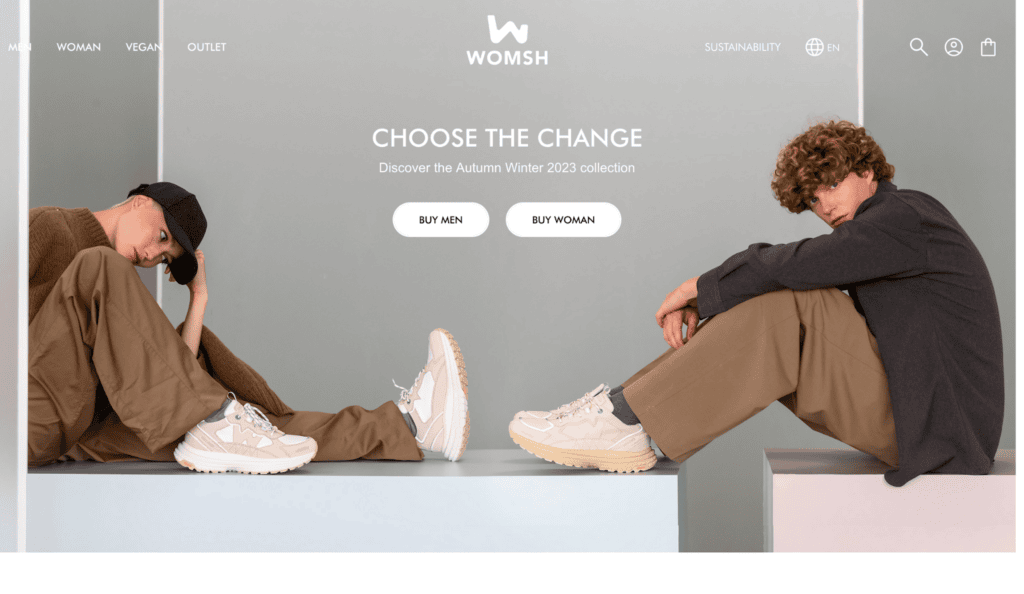
“Womsh (Word Of Mouth Shoes): starting with our name, with each word, we want to promote a more conscious and environmentally friendly purchasing philosophy. We would like to create a tribe of people who think, choose and start to change the world with their small yet effective everyday gestures.”
Womsh
🌎
How do they ensure their sustainability?
Womsh prioritizes sustainability by sourcing a medium proportion of eco-friendly textile and packaging materials, opting for low-impact production, and implementing incentives to reduce their carbon footprint.
- Firstly, they lower their environmental impacts by using 100% recycled cardboard for packaging and transitioning into using vegan leather AppleSkinTM (50% apple fiber and 50% Polyurethane) in their streetwear.
- Secondly, they opt for a metal-free tanning process for the leather used in the uppers of some shoe models and for the lining of the entire collection, guaranteeing safety for people’s health and for the environment.
- Lastly, their carbon footprint reduction incentives include relying on clean and renewable sources for 90% of the energy needed in the main manufacturing factory, keeping sourcing and manufacturing locally within Italy to avoid long-distance transportation and its associated carbon emission, and offsetting carbon emissions with the project Zero Impact under their partnership with LifeGate.
🌐
How do they ensure their ethics?
Womsh traces most of their supply chain and ensures payment of a living wage for some suppliers. The workers who produce their shoes are paid according to European standards and provided with a safe and healthy working environment.
🤝
Are they part of any giving-back programs?
Womsh participates in recycling projects where their sneakers are collected and taken apart so that the upper parts can be turned into granular material. Such materials are used in children’s playgrounds as anti-shock flooring.
🛍️
What is their product range?
- Best for: menswear, womenswear
- Product range: sneakers
- Price range: $$$
- Size range: XS–XL
Beaumont Organic: Create “Contemporary Conscious Clothing” Responsibly


“We work hard behind the scene to provide you with full transparency into the sustainability of our practices and our suppliers”
Beaumont Organic
🌎
How do they ensure their sustainability?
Beaumont Organic prioritizes sustainability by sourcing low-impact materials, using renewable energy in their supply chain, and reducing waste by both using recycled packaging and offering clothes repairs.
- Additionally, they promote textile circularity with their online circular resale scheme, allowing customers to pass their pre-loved garments onto a new home.
- The brand also features organic fabrics (organic linen and organic cotton certified by the Global Organic Textile Standard).
- Lastly, they use recycled fabrics, lowering their impact while reducing textile waste.
🌐
How do they ensure their ethics?
Beaumont Organic is fully transparent about the final stage of their clothes, wherein they use European factories that pay fair wages and have good working conditions. Beaumont Organic also uses wool accredited by the Responsible Wool Standard, guaranteeing the welfare of the animals in their supply chain.
🤝
Are they part of any giving-back programs?
The Beaumont Organic Foundation has supported various community give-back projects in Fiji, including hospital renovations.
🛍️
What is their product range?
- Best for: womenswear, baby wear, homeware, accessories
- Product range: shirts, pants, jackets, blazers, knitwear, blouses, underwear
- Price range: $$$
- Size range: XS–XXL
Leather Fabrics: Durable Material With Superior Strength
Leather is a durable material traditionally used in products requiring strength, like shoes and outdoor protective gear. However, common practices in modern-day leather production involve many toxic chemicals and unethical sourcing.
Here are the life-cycle stages of leather fabrics and each stage’s sustainability assessment:
- Sourcing of leather fabrics: Sourcing animal skins for leather can only be sustainable if animal farming or hunting follows reasonably sustainable practices. Sourcing animal skin, which has long been considered waste from the meat industry, reduces waste instead of straining natural resources. However, some animal skins are high-value products, and sourcing these materials would help subsidize keeping animals for the meat industry, which is too often plagued with unsustainable and unethical practices, from deforestation to animal cruelty. Alternatively, sourcing leather deadstock and leftovers is sustainable as it bypasses the high-impact farming stage.
- Manufacturing of leather fabrics: Manufacturing leather is generally unsustainable. Chemical tanning in leather production is energy and chemical-intensive. Manufacturing waste contaminates water and airways. Vegetable tanning doesn’t use toxic synthetic chemicals but takes a lot longer and generally produces more sturdy leather.
- Transportation of leather fabrics: Transporting can be a carbon-intensive stage in the life-cycle of clothing items made with leather fabrics due to the distances covered and emissions associated with transporting vehicles. Leather fabrics typically travel from slaughterhouses, where animal skins are obtained, or collection hubs (in the case of recycled leather) to processing and finishing factories, sorting centers, shops, and consumers’ homes before going to recycling centers or landfills.
- Usage of leather fabrics: The usage of leather is generally sustainable because of its durability. Quality leather products can last a lifetime if they are taken care of. Cowhide leather’s durability is down to its strength, which is superior to that of leather alternatives (artificial, plant-based leather, or plant-plastic hybrid leather fabrics).
- End-of-life of leather fabrics: The end-of-life stage for leather is generally not very sustainable because the heavy use of chemicals in manufacturing hinders the biodegradability of this material.
Leather fabrics are generally considered unsustainable textile materials because of the resource-demanding farming stage and the chemical-intensive tanning process. Upcycled leather has lower environmental impacts because recirculating leather waste reduces pressure on land, water, and other resources needed to raise animals and avoids the adverse environmental impacts of chemical tanning.
Why Is It Important to Buy Products Made of More Sustainable Fabrics
It is important to buy products made of more sustainable fabrics because a sustainable textile industry has a lower carbon footprint, helps save natural resources, and is better for forests, animals, and humans.
Buying Sustainable Fabrics Reduces Your Carbon Footprint
The production of clothing and footwear is estimated to contribute 10% of global greenhouse gas emissions—more than all international flights and shipping combined. If the fashion industry were a country, it would be the fourth largest emitter of carbon dioxide.
One way to reduce the carbon footprint of the clothes you buy is to opt for sustainable fabrics. Sustainable fabrics, which are often made with natural or recycled fibers, have relatively low carbon footprints compared to petroleum-based fabrics. For example, organic cotton made in the US has a carbon footprint of 2.35 kg CO2 (per ton of spun fiber)—a quarter of polyester’s carbon footprint.
Buying Sustainable Fabrics Reduces Demand For Natural Resources and Waste Management
The textile industry uses water and land to grow leather and other fibers. It is estimated that 79 billion cubic meters of water were used for the sector worldwide in 2015. For example, producing a single cotton T-shirt requires as much water as one person drinks for 2.5 years (2,700 liters of fresh water).
Worse yet, the textile economy is vastly more linear than circular: the largest amount of resources used in clothes ended up in landfills (instead of being recycled to remake clothes). According to a report by the Ellen MacArthur Foundation,
- Less than 3% of materials used in the textile economy in 2015 came from recycled sources.
- In other words, more than 97% of resources used in making clothes are newly extracted.
When clothing items are disposed of within a short period of time—under a year in the case of half of the fast fashion clothes—the natural systems that provide raw materials for fabrics don’t have enough time to recover and regenerate, which could lead to ecological breakdown.
Sustainable fabrics are made with less water and emissions while lasting longer:
- Because they are durable, you don’t need to buy new clothes too often.
- Thus, you help reduce the pressure to extract more resources for making new items.
Similarly, making and consuming sustainable fabrics made with recycled materials reduces the demand for virgin materials while helping tackle waste management.
Buying Sustainable Fabrics Encourages Sustainable Management of Forests
Sustainable plant-based fabrics are made with raw materials from forests and plantations that are sustainably managed, such as complying with FSC standards.
When you buy sustainable plant-based fabrics, you discourage unsustainable forestry practices like illegal logging. You can help reduce deforestation, biodiversity loss, and the effects of climate change.
Buying Sustainable Fabrics Encourages Fairer Treatment of Animals
The fashion industry is rife with animal mistreatment when it comes to making animal-based fabrics like leather or leather. Every year, billions of animals suffer and die for clothing and accessories.
Buying sustainable vegan alternatives can help to reduce the pressure on raising more and more animals to meet the demand for animal-based fabrics while sacrificing their well-being and lives.
Suppose you have to buy fabrics made with, for example, leather or leather; make sure you only choose brands committed to cruelty-free products. In that case, you help advocate better treatments for animals raised within the textile industry.
Using Sustainable Fabrics Encourages Fairer Treatment of Textile Workers
Recent statistics from UNICEF estimated as many as 170 million child laborers worldwide, many of whom were engaged in some form of work in the textile industry. They don’t get paid minimum wages and often work long hours.
When you buy sustainable fabrics from brands transparent about the working conditions at their factories, you discourage the use of child labor and help promote better working conditions for textile workers.
How Can You Generally Buy More Sustainable Fabrics
The key to sustainably buying fabrics is to check on relevant environmental and original certifications.
For natural fabrics:
- Global Organic Textile Standard (GOTS): A globally-recognized certification system that ensures a certain threshold of organic content has been met. It covers manufacturing, packaging, labeling, transportation, and distribution (but not what happens in the fields where crops are grown).
- USDA Certified Biobased Product: The USDA BioPreferred® Certification is a voluntary certification offered by the United States Department of Agriculture. The certification identifies products made from plants or other renewable materials.
- Ecolabel: Ecolabel is the official European Union voluntary label recognized worldwide for certified products with a guaranteed, independently-verified low environmental impact. The label requires high environmental standards throughout the entire life-cycle: from raw material extraction through production and distribution to disposal. It also encourages companies to develop innovative, durable, easy-to-repair, and recyclable products.
For plant-based semi-natural/semi-synthetic fabrics:
- Forest Stewardship Council: An FSC certification ensures that the leather (or leather-like material) comes from responsibly managed forests that provide environmental, social, and economic benefits.
There are two types of FSC Certification:- FSC Forest Management Certification, with a focus on the origin of the wood—the forest.
- FSC Chain of Custody Certification, which focuses on the path from the forest to the customer’s home.
- Program for Endorsement of Forest Certification: PEFC’s approaches to sustainable forest management are in line with protecting the forests globally and locally and making the certificate work for everyone. Getting a PEFC certification is strict enough to ensure the sustainable management of a forest is socially just, ecologically sound, and economically viable but attainable not only by big but small forest owners.
For recycled fabrics:
- Recycled Claim Standard (RCS): The Textile Exchange RCS was originally developed as an international, voluntary standard that sets requirements for third-party certification of recycled input and chain of custody.
- The Global Recycled Standard (GRS): The Global Recycled Standard (GRS) is an international, voluntary, full product standard that sets requirements for third-party certification of Recycled Content, chain of custody, social and environmental practices, and chemical restrictions. It can be used for any product with more than 20% recycled material.
For all types of fabrics:
- STeP by OEKO-TEX®: STeP by OEKO-TEX® is an independent certification system for brands, retailers, and manufacturers from the textile and leather industry. It communicates organizational environmental measures, including reducing carbon footprint and water usage.
- OEKO-TEX® Standard 100: OEKO-TEX® labels aim to ensure that products pose no risk to human health (i.e., containing banned chemicals).
Some certifications that are signaling brands’ efforts toward lowered environmental impacts and a circular economy are:
- B Corp Certification: The label B Corp is a certification reserved for for-profit companies. Certified holders are assessed on their social and environmental impacts.
- Cradle2Cradle certification: Cradle2Cradle provides a standardized approach to material circularity. It assesses whether products have been suitably designed and made with the circular economy in mind covering five critical categories: material health, material reuse, renewable energy and carbon management, water stewardship, and social fairness.
Final Thoughts
Leather fabrics are generally considered unsustainable textile materials because of the resource-demanding farming stage and the chemical-intensive tanning process. However, it is possible to find eco-friendly leather products made with leather deadstock or from certified vegetable-tanned sources.
By purchasing new or pre-loved leather clothes from brands that commit to sustainability, you support their mission to create a fairer and less harmful textile industry for all lives on Earth.
Here is the list (again) of the most sustainable hemp clothing brands:
- HYER GOODS
- BEEN London
- Better World Fashion
- Baukjen
- Reformation
- CARIUMA
- Nothing New
- VEJA
- Womsh
- Beaumont Organic
To make your use of these fabrics even more sustainable, follow these steps:
- Buy second-hand, recycled, or upcycled clothes made of sustainably manufactured leather.
- While using leather clothes, maximize the number of wears between washes and keep them as long as possible.
- At the end-of-life of your leather clothes, upcycle the materials to extend their usage and arrange for them to be recycled or properly disposed of.
Stay impactful,

Sources
- Impactful Ninja: How Sustainable Are Leather Fabrics? A Life-Cycle Analysis
- Science Direct: Life-cycle assessment (LCA)
- HYER GOODS: Home
- BEEN London: Home
- Better World Fashion: Home
- Baukjen: Home
- Reformation: Home
- CARIUMA: Home
- VEJA: Home
- Woosh: Home
- Beaumont Organic: Home
- HYER GOODS: Deadstock Leather Blazers
- HYER GOODS: Our Materials
- HYER GOODS: Luxury Leftovers
- HYER GOODS: Deadstock Leather Collection
- Impactful Ninja: How Sustainable Are Wool Fabrics? A Life-Cycle Analysis
- Impactful Ninja: How Sustainable Are Canvas Fabrics? A Life-Cycle Analysis
- HYER GOODS: Carbon Neutrality
- Good On You: Brand Directory | HYER GOODS
- HYER GOODS: Our Monthly Mission
- Malala Fund: Home
- WHO: Home
- No Kid Hungry: Home
- The Okra Project: Home
- BEEN London: What is a circular economy?
- Good On You: Brand Directory | BEEN London
- Textile Exchange: Global Recycle Standard
- BEEN London: Our Innovative Materials
- Impactful Ninja: How Sustainable Are Recycled Nylon Fabrics? A Life-Cycle Analysis
- Impactful Ninja: How Sustainable Are Recycled Polyester Fabrics? A Life-Cycle Analysis
- Impactful Ninja: How Sustainable Are Recycled Cotton Fabrics? A Life-Cycle Analysis
- Impactful Ninja: How Sustainable Are Piñatex Fabrics? A Life-Cycle Analysis
- Impactful Ninja: How Sustainable Are AppleSkinTM Fabrics? A Life-Cycle Analysis
- BEEN London: BLACK FRIDAY AND GIVING TUESDAY BAG SWAP
- BEEN London: Our Ethos
- BEEN London: Our tree planting initiative
- BEEN London: Rainforest Green
- Tree-Nation: BEEN London forest
- Smart Work: Home
- Good On You: Brand Directory | Better World Fashion
- Better World Fashion: SUSTAINABILITY
- Better World Fashion: BUY-BACK GUARANTEE
- Better World Fashion: RENTAL
- B Corporation: House of Baukjen
- Baukjen: Our Fabrics
- Baukjen: Ecotec recycled cotton
- Baukjen: Recycled wool
- Baukjen: Recycled cashmere
- Baukjen: Newlife recycled polyester
- Baukjen: Recycled down
- Baukjen: Sustainable Impact Report Quarter 2 2023
- Baukjen: Impact Report 2022
- Baukjen: Ecojilin viscose
- Canopy Planet: Hot Button Report
- Baukjen: Pre-Loved Collection
- Baukjen: Women’s Clothing Rental
- Baukjen: Wear, Care & Repair
- Baukjen: Factories
- Good On You: Brand Directory | Baukjen:
- International Labour Organization: Home
- International Labour Organization: ILO Declaration on Fundamental Principles and Rights at Work
- Baukjen: Sustainable Attributes
- Baukjen: We are Baukjen
- NHS Charities Together: Home
- World Land Trust: Home
- Baukjen: Philanthropy
- Reformation: Sustainability
- Impactful Ninja: How Sustainable Are TENCELTM Fabrics? A Life-Cycle Analysis
- TencelTM: TENCEL™ x REFIBRA™ technology
- Reformation: Circularity
- Reformation: RefRecycling
- Vestiaire Collective: Reformation leather
- Reformation: What is RefScale
- CLIMATE NEUTRAL: Reformation
- The Reformation: Supplier Code of Conduct
- International Labor Organization (ILO): Home
- Reformation: Supplier Code of Conduct
- Reformation: Factories
- Transparency Pledge: Home
- Open Supply Hub: Home
- Fair Labor Association: Home
- B Corporation: CARIUMA
- CARIUMA: EMPOWERING SUSTAINABLE CHOICES | Materials
- CARIUMA: What is Ethically Sourced Leather?
- CARIUMA: EMPOWERING SUSTAINABLE CHOICES | Operations
- CARIUMA: EMPOWERING SUSTAINABLE CHOICES | Factories
- CARIUMA: Code of Conduct
- Good On You: Brand Directory | CARIUMA
- CARIUMA: Leather sneakers
- CARIUMA: Animal Welfare Policy
- Leather Working Group: Home
- CARIUMA: REFORESTATION PROGRAM
- Nothing New: Carbon Neutral Commitment
- Textile Exchange: Global Recycle Standard
- Nothing New: Our Materials
- Impactful Ninja: How Sustainable Are Leather Fabrics? A Life-Cycle Analysis
- Leather Working Group: Home
- Nothing New: Virtuous Circle Program
- Good On You: Brand Directory | Nothing New
- Impactful Ninja: How Sustainable Are Jute Fabrics? A Life-Cycle Analysis
- VEJA: Leather
- VEJA: The blindness around CO2 emissions
- VEJA: Limits
- VEJA: Fair trade
- VEJA: Production
- Good On You: Brand Directory | VEJA
- VEJA: Reintegration
- Good On You: Brand Directory | Womsh
- Womsh: OUR MATERIALS
- Womsh: OUR ACTIONS
- Zero Impact: Home
- Good On You: Brand Directory | Beaumont Organic
- Beaumont Organic: Shipping & Delivery
- Beaumont Organic: Repair Scheme
- Beaumont Organic: Resale Scheme
- Impactful Ninja: How Sustainable Are Organic Linen Fabrics? A Life-Cycle Analysis
- Impactful Ninja: How Sustainable Are Recycled Fabrics Fabrics? A Life-Cycle Analysis
- Beaumont Organic: Leather
- Beaumont Organic: Our Sustainable Story
- Beaumont Organic: The Beaumont Organic Foundation
- European Parliament: The impact of textile production and waste on the environment (infographic)
- Science Direct: The challenge of “Depeche Mode” in the fashion industry – Does the industry have the capacity to become sustainable through circular economic principles, a scoping review
- Science Direct: Carbon Footprint of Textile and Clothing Products
- European Parliament: Environmental impact of the textile and clothing industry
- European Parliament: What if fashion were good for the planet?
- Ellen MacArthur Foundation: A New Textiles Economy: Redesigning fashion’s future
- McKinsey: Style that’s sustainable: A new fast-fashion formula
- Forest Stewardship Council: Home
- Our World in Data: Deforestation and Forest Loss
- Our World in Data: Renewable Energy
- Peta: Animals Used For Clothing
- The Guardian: Child labour in the fashion supply chain
- BioPreferred: WHAT IS THE BIOPREFERRED PROGRAM?
- European Commission: Environment | EU Ecolabel
- Forest Stewardship Council
- FSC Forest Management Certification
- FSC Chain of Custody Certification
- Program for Endorsement of Forest Certification
- Impactful Ninja: How Sustainable Are Semi-Natural/Semi-Synthetic Fabrics? A Life-Cycle Analysis
- OEKO-TEX: Certification according to STeP by OEKO-TEX®
- OEKO-TEX: OEKO-TEX® Standard 100
- B Corp Certification: Home
- C2CCertified: Home
